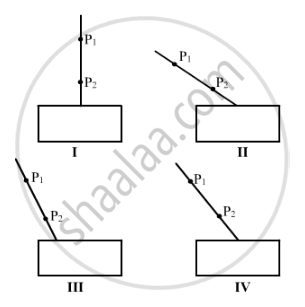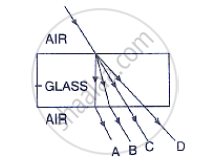Advertisements
Advertisements
प्रश्न
The diagram shows the path of a ray of light through a rectangular glass block placed in a liquid of uniform density.

What is the angular, deviation of the emergent ray from the glass block with respect to the incident ray?
उत्तर
As shown by the line in the diagram, the emergent ray is parallel to the incident ray (when produced) and so there is no angular deviation.
APPEARS IN
संबंधित प्रश्न
Define refraction and state the laws of refraction.
Study the following four experimental set-ups I, II, III and IV for the experiment, "To trace the path of a ray of light through a rectangular glass slab."

Which of the marked set-ups is likely to give best results (P1 and P2 are the positions of pins fixed on the incident ray)?
(A) I
(B) II
(C) III
(D) IV
On the basis of the experiment, "To trace the path of a ray of light through a rectangular glass slab", students of a class arrived at which one of the following conclusions?
(A) Angle of incidence is greater than the angle of emergence.
(B) Angle of emergence is smaller than the angle of refraction.
(C) Emergent ray is parallel to the refracted ray.
(D) Incident ray and emergent ray are parallel to each other.
A ray of light passes from water to air. How does the speed of light change?
In fig 4.18, name the ray which represents the correct path of light while emerging out through a glass block.

Define the term refractive index of a medium. What do you understand by the statement 'the refractive index of glass is 1.5 for white light'?
Which of the following has the highest refractive index:
Name the phenomenon responsible in the following case:
Apparent bending of a stick in water
What do you understand by the deviation produced by a prism?
How will you verify the laws of refraction or how the refractive index of glass is determined in the laboratory?
